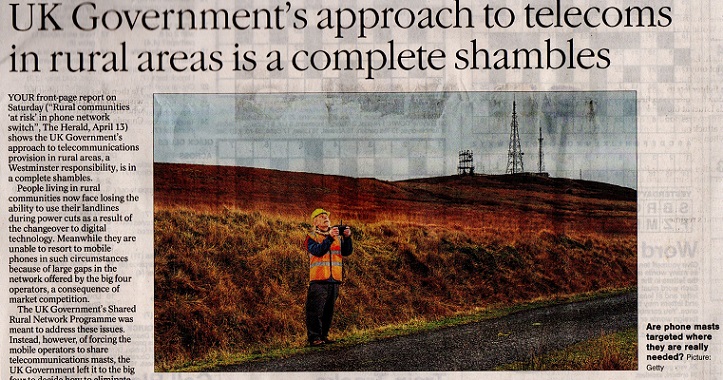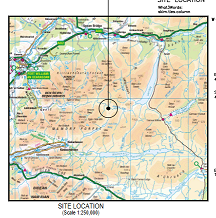 I was pleased to have this letter, full text below, published in the Herald on Tuesday. I hope it speaks for itself:
I was pleased to have this letter, full text below, published in the Herald on Tuesday. I hope it speaks for itself:
“Your front page report on Saturday (Rural communities ‘at risk’ in phone network switch 13th April see here) shows the UK Government’s approach to telecommunications provision in rural areas, a Westminster responsibility, is in a complete shambles.
People living in rural communities now face losing the ability to use their landlines during power-cuts as a result of the changeover to digital technology. Meanwhile they are unable to resort to mobile phones in such circumstances because of large gaps in the network offered by the big four operators, a consequence of market competition.
The UK Government’s Shared Rural Network Programme was meant to address these issues. Instead, however, of forcing the mobile operators to share telecommunications masts, the UK Government left it to the big four to decide how to eliminate the hundreds of “partial not spots” around local communities. This has resulted in proposals to erect yet more phone masts around local communities by operators unwilling to co-operate, even in places like National Parks where the landscape is supposed to be protected.
Meantime the UK Government decided to pay these same mobile phone operators £500m to eliminate “total not spots”, areas where there is no existing 4G coverage. Most of the total not spots, as Vicky Allan described two months ago (Highland phone masts will cost millions. Will anyone benefit? 25th February see here), lie within Wild Land Areas. These are valued by rural communities and visitors alike precisely because they lack human infrastructure. For those who need it for safety or other purposes, communication in Wild Land Areas is now readily available and more reliably provided through satellite technology.
The UK Minister for Science, Innovation and Technology, Julia Lopez, is responsible both for the transfer of landlines to Voice over Internet Protocol technology and the Shared Rural mobile network. She would be far better using part of the £500m the UK Government is wasting on eliminating total not spots in creating a reliable telecommunications network for the rural areas where the vast majority of people actually live, travel and work.”
I had previously commented (see here) that with rural areas in Scotland crying out for investment the £500m would have been far better spent on other things. I had not appreciated, however, that one of the areas where rural investment is required is to provide backup to landlines which will otherwise be affected by power-cuts as a result of the transfer over to the new digital telecoms system.
While there are no clear plans at present to provide battery or other back-up to landlines when the mains electricity network is disrupted, almost every planning application for a mobile mast in a Total Not Spot includes a back-up power supply!
Here is an example from a recent application (see here) to erect a mast near Meanach bothy between the Mamores and Grey Corries:
 “The proposed mast and apparatus will be predominantly powered by renewables. This will be achieved through 4x solar arrays which are shown on the drawings and will be located within the compound.
“The proposed mast and apparatus will be predominantly powered by renewables. This will be achieved through 4x solar arrays which are shown on the drawings and will be located within the compound.
Each solar array (4No) is 3kW nominal (full sun); but will deliver in the region of 400-600W per array average throughout the year. May – Sept will basically operate 100% on solar, but between Oct -Apr will need more generator input.
However, there is also battery storage, and it is quite central to the solution (it is a ‘hybrid’ solution). It fulfils the load until emptied at which point it needs to pull power from a generator. The generator will use HVO and is more of a backup than a primary source. HVO, or Hydrotreated Vegetable Oil is a ‘cleaner’ solution than traditional diesel by using non fossil fuel and reducing the carbon footprint from the site. Importantly, this generator is a back-up and will only be used when either the solar arrays are not providing power and/or when the battery needs topping up.
The noise from the generator is generally attenuated as it is housed within the container. The
generator produces 66dB(A) at 7m. Sound also attenuates over distance as per the equation
below: SPL2 = SPL1 – 20 log (R2/R1) ; SPL1 is Sound at point 1 (66 dB(A) at 7 metres) SPL2 is sound at point 2 (calculated), R1 is 7 metres. If R2 is 300m, the perceived sound would be about 33dB(A), which is quite low (even in a remote and rural area).”
Not just one but TWO types of power back-up in this case, all being funded by the UK Government! This is for a telecommunications mast which is being proposed in the heart of a National Scenic Area – hence it requires full planning consent – as well as a Wild Land Area and will provide a service to almost no-one. The UK Government is sparing no expense one wrecking some of Scotland’s most important landscapes while the needs of the rural communities who live outside these remote areas are being totally ignored.
The utter stupidity of this should have provided an open goal for politicians in Scotland and the Scottish Government in particular. Unfortunately the Scottish Government’s own record when it comes to making sensible use of public investment in rural areas, including National Parks, is hardly above criticism (recent examples covered on Parkswatch include the £50m plus wasted on the funicular and the forestry grants awarded to BrewDog). As usual it is likely to take public pressure to change that.
People who are concerned about the destruction of wild landscapes should be encouraged by the signs that campaigning to stop masts, both in the form of complaints to politicians and objections to planning applications, is working. Earlier this month the Shared Rural Network programme published a map showing masts proposed for Total Not Spots (see here). Until now they had tried to keep this information secret. However various Freedom of Information requests, including from other contributors to parkswatch, appear to have forced them to become more public.
As significantly, the explanation accompanying the map shows there has been a 20% reduction in the number of masts proposed:
“Developing a radio plan is an iterative process. Originally it was estimated that around 315 sites would be needed to meet coverage obligations. The current plan has 262 sites, but we aim to achieve the obligation with fewer sites.”
That still leaves no less than 15 masts proposed for the wilder parts of the Cairngorms National Park, for example, and doesn’t change the fundamental issue that the UK Government needs to scrap the obligation on operators to provide 4G coverage in wild land areas but it is a step forward. If you haven’t done so already, therefore, please consider contacting your local councillors (if living in a rural areas), MSPs and MPs and ask them to call for the £500m SRN monies to be redirected to where needed.
And please, if you have the time, also consider commenting on the proposed mast near Meanach bothy referred to above. Some excellent objections have been lodged on the Highland Planning Portal, which describe why this mast is completely unacceptable (see here), but its best to say in your own words why you value the area and why you don’t need or want a mast in this and other similar locations.
Good to see the detail and implications being spelled out in clear terms. The more people get behind this the better. The SG seems not to want to get involved but perhaps more public pressure will force a rethink.
One application for a mast near Strawberry Cottage in Glen Affric was withdrawn after a storm of protest which I believe included JMT and Mountaineering Scotland (I may be wrong) but another appeared last week less then a km away. WTF ?!
Two new applications for masts in Glen Affric have appeared on the planning authority portal in recent days:
https://wam.highland.gov.uk/wam/applicationDetails.do?keyVal=SB1VRBIHFUZ00&activeTab=summary
https://wam.highland.gov.uk/wam/applicationDetails.do?keyVal=SB0KO3IHFTN00&activeTab=summary
Following on from my previous, just found another application for about 2 miles away on “North Of Loch Affric ..Valley”. WTF x2
Objection submitter for 24/01186/FUL and 0081!. Don’t yet appear on website
I’ve objected to both. Comments are taking several days at least to appear. Probably wading through treacle.